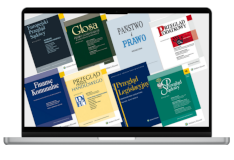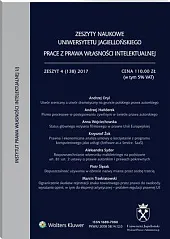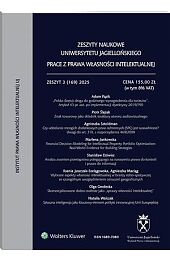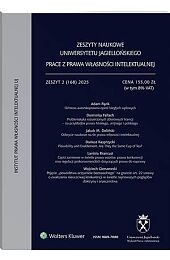Andrzej Oryl
p. 5
Andrzej Hańderek
p. 23
Anna Wojciechowska
p. 64
Krzysztof Żok
p. 67
Aleksandra Sydor
p. 79
Piotr Ślęzak
p. 93
Marcin Trzebiatowski
p. 105
Andrzej Oryl
Stage work and dramatic work in the Polish copyright law
Although not expressly mentioned in the text of the Berne Convention, the term ’stage work‘ does have a long tradition in the Polish legal system: it appeared in all three Polish Copyright Acts. On the other hand, the term ‘dramatic work‘, well-grounded in the provisions of the Berne Convention, was referred to in only one sentence of the Copyright Act of 1926 and has never since been used in Polish legislation. This gives rise to the question about the meaning of the above-mentioned terms in the Polish copyright law.
In fi rst two codifi cations, ‘stage work’ was simply a Polish version of ‘dramatic work’, the term used in the Berne Convention and meaning a literary work intended to be disseminated via print and/or by public performance. As a result the terms ‘dramatic work’ and ‘stage work’ were used interchangeably and the playwright responsible for the creation of storyline as well as dialogues was considered to be the sole author of the work. Such understanding was accepted by both legal scholars and courts. Nevertheless it has to be stressed that a theatre performance or a stage show were also recognized - by at least some academics - as possible types of works that could be protected under copyright law.
The defi nition of dramatic work provided above remains valid till this day. The legislature’s view of stage work, however, changed substantially with the introduction of the Act on Copyright and Related Rights of 1994. From that moment stage work as well as musical stage work become new types of works, different from respectively: dramatic and dramatico-musical work. Listed alongside choreographic and pantomime works, they are now stage shows, established and communicated thorough actions of artistic performers (mainly actors) that are not necessarily fi xed in any material form. Beside artistic performances, other works protected by copyright, such as for example: musical, choreographic or pantomimic works, may be considered components of a stage work. All those ingredients are mixed and orchestrated by the stage director who is the principal, but not necessarily the only, author of a stage work or a musical stage work. The multidisciplinary nature these works opens them to a possibility of co-authorship, but there are no formal obstacles for stage works or musical stage works to be created and performed only one person.
This does not mean that each and every theatre performance or similar event should be considered a stage work. The general rule in Art. 1 of the Polish Copyright Act applies here: it is only a manifestation of creative activity of individual nature, fi xed in any form - irrespective of its value, designation or manner of expression – that may be considered an object of copyright. In my opinion, in case of stage work and/or musical stage work these features are present in the means of expression used on stage, especially the relations between performances and works being components of a stage work.
The current understanding of the term ‘stage work’ creates new possibilities in the area of interdependencies between a stage work and a dramatic work. First of all, one may be a derivative work with respect to another or serve as a source of inspiration. Secondly, since a stage work may exist even without a classical plot or dialogues, both types of work may stay completely independent of each other. Last but not least, if a dramatic work is created as a script for a specifi c stage show, the playwright may be considered as one of the co co-authors of that stage work or musical stage work.
Another vital issue related to stage works and stage and musical works is distinguishing between both types of works. It seems that the only difference between them is the importance of music for the overall experience created for the viewers. Apart from this aspect, in the fi eld of means of expression, stage works and musical stage works are similar. Taking into consideration that music may also be a vital part of an ‘ordinary’ stage work, the distinction between stage works and musical stage works seems to be a very questionable legislative decision.
The Polish regulation regarding stage works and musical stage works is very short and leaves many unanswered questions, regarding both the exercise of copyright in these works as well as their very nature. The legislature should defi nitely supplement and expand the existing provisions in future amendments to the Act on Copyright and Related Rights.
Back to top
Andrzej Hańderek
Pleadings in civil proceedings in the light of copyright law
This article is an attempt at answering the question whether pleadings in civil proceedings constitute works within the meaning of copyright law. The author analyses the possible approaches to these issues, taking into account the current case law and views of legal scholars. The article draws attention to the practical aspect of the aforementioned issues, particularly the impact of copyright laws on the possibility and extent of use of pleadings.
These issue can have a signifi cant impact on the trial. Since the adopted concept of a pleading determines the respective scopes of rights vested in the author, participants in the court proceedings and third parties. As a rule, a pleading as a work expressed in words is subject to copyright protection, at least until it is fi led with a court. From this point, determining the status of the pleading and the copyright law regulations that should apply becomes important. The author rejects the possibility of accepting that a pleading is an offi cial document or offi cial material. A pleading cannot be considered an offi cial document or offi cial material, because it lacks an offi cial nature (it is not created by an offi ce). Moreover, one of the consequences of adopting this concept would be a kind of ‘expropriation’ of authors whose pleadings are submitted to the courts, which undoubtedly gives rise to objections as to the constitutionality of such a solution.
In addition, we should reject the concept that the pleading is a work enjoying full copyright protection, with the exception of the possibility of relying on private use, the right of quotation (because the work is not disseminated), and the statutory license referred to in Art. 332 of the Polish Copyright and Related Rights Act of 1994. The reason for rejecting this concept is primarily pragmatic. If we assume that a pleading enjoys full copyright protection and, additionally, that its submission to the court does not constitute its dissemination, it would in essence make it impossible to work with court records.
In the author’s opinion, a pleading is disseminated within the meaning of the Polish Copyright and Related Rights Act of 1994 when it is fi led with a court or, in the case of pleading sent by post or courier, when a court employee receives it. This is the moment when it becomes possible for an indefi nite circle of people to acquaint themselves with the pleading.
In addition, the author explicitly points out the lack of possibility to rely on the Public Information Access Act of 2001 in order to use the case fi les, including pleadings contained therein. Therefore, the author is in favor of recognizing a pleading as a work under the copyright law and indicates the normative basis for such an approach. The pleading is a work expressed in words, similar to literary and scientifi c works. Its similarity to literary works can be found in the descriptive part, including in particular the choice of relevant facts of the examined case, as well as the selection and arrangement of the words. In turn, its similarity to scientifi c works can be seen in the analysis and interpretation of the law and facts, as well as the argumentation, often supported by references to case law and the views of legal scholars. According to the author, the use of pleadings by the individuals involved in civil litigation, who are not their authors, is based on Art. 332 of the Polish Copyright and Related Rights Act of 1994. In addition, the author points out that submitting a pleading to the court does constitute its dissemination, therefore it is possible to use it in the context of private use and the right of quotation. The scope of use of a pleading will be determined by the procedural rules relating to the operation of the court.
Back to top
Anna Wojciechowska
The status of a fi lm’s principal director under EU law
The belief about the fi lm director’s superior role among fi lm creators started to dominate in fi lm theory in the 1960s and since then the director’s importance has been growing, also in copyright law. The ‘principal director’ as a category was fi rst introduced as a normative term in the Berne Convention for the Protection of Literary and Artistic Works, in the Stockholm revision of 1967, from which it was subsequently adopted in the contents of EU directives. The basics of the legal regulation of the ‘principal director’ category were outlined in Directive 92/100/EEC on rental right and lending right and on certain rights related to copyright. The principal director of a cinematographic or audiovisual work was, for the purposes of this Directive, identifi ed as its author or one of its authors (Art. 2(2) fi rst sentence). This solution started the process of strengthening the principal director’s position. It was then reinforced by the adoption of Directive 93/98/EEC harmonizing the term of protection of copyright, where (in Art. 2(1)) the category of ‘principal director’ was made a universal one.
As for the scope of copyright enjoyed by the principal director, even though a literal interpretation of EU directives provides no grounds for giving the principal director a privileged position also in this regard, in EU literature and case law we can notice a tendency of interpreting these provisions more broadly and treating the principal director more favourably. This is particularly visible in CoJ judgment in case C-277/10, Luksan, where the Court holds that it is not only the rights listed in the Directives (rental right, lending right, satellite broadcasting right) that vest in the principal director by operation of law, directly and originally, but also other rights of exploitation of the cinematographic work, such as reproduction right and right of communication to the public through the making available to the public, as well as right to the fair compensation under the ‘private copying’ exception. While accepting the possibility of applying, with respect to the principal director, the principle of presumed transfer of rights from performers to the fi lm producer, expressed in Art. 2(5) of Directive 92/100/EEC, the Court also tried to give the best possible protection to the interests of the principal director, by formulating a condition that such a presumption could not be a non-rebuttable one, as that would exclude the possibility of a different contractual arrangement with the principal director. The tone and direction of the Court’s statements indicate, therefore, that recently the status of the principal director of a fi lm improved considerably under EU law. However, the decisions favourable to the principal director are not accompanied by refl ections and arrangements aiming to protect the sphere of rights of the remaining creators of the fi lm and its producer.
Back to top
Krzysztof Żok
Legal and economic analysis of software as a service (SaaS) agreements
The purpose of the paper is to analyse the legal nature of software as a service (SaaS) agreements from the perspective of law and economics. The article presents a general economic model of copyright law, encompassing the remarks about: (1) the status of a copyrighted work as a good in the light of microeconomics, (2) the costs of providing the work and (3) the status of the work as an innovation in the economic sense.
The analysis begins with qualifying copyrighted works as public goods. The conclusion results from the fact that the use of copyrighted objects, including computer programs provided on media, exhibits lack of rivalry and excludability. Exploitation of the work leads also to the so-called free-rider problem: the person interested in the intellectual result may in fact benefi t from it without paying the fee. This statement also holds true in the context of software fi xed on media. Consequently, public goods constitute a source of market failures, what in turn justifi es a legislative intervention.
From this perspective copyright law is perceived as a means of weakening the negative features of the work as a public good. As a result of granting exclusive rights, the author acquires a possibility of excluding unauthorized users from exploiting the work. Thus copyright law transforms a work into a quasi-private good.
The costs of communication of the work to the public consist of (1) the costs of expression and (2) the costs of producing a copy of the work. The former are connected with the creation of the object and their amount is invariable. The latter, in contrast, arise as a consequence of fi xing the work on media. Their amount depends therefore on the number of created copies. Moreover, the costs of expression are much higher than the costs of producing a copy of the work. The disparity mentioned above is unfavourable for the author due to the status of the work as a public good, because it is more profi table for the competitors to copy someone else’s work than to create their own work, even though the latter behaviour is in the interest of all. Consequently, the number of works on an unregulated market would usually be suboptimal, because the incentive for undertaking the creative activity is lacking. The conclusion is important particularly in the context of software, where the disparity of costs is especially visible. Copyright law counteracts these negative consequences by granting exclusive rights to the intellectual result. The author may thus successfully demand a fee from the user and prevent the copying of the intangible good without permission.
A work, particularly a computer program, may be also regarded as an innovation in the economic sense. In this case the intellectual good introduces a market disequilibrium, allowing the author to achieve extraordinary profi ts. The profi ts should be used in the fi rst place to cover the costs of creating the work. This conclusion arises from the fact that competition contributes to the propagation of the innovation, which in turn leads to the reduction of extraordinary profi ts. The market returns fi nally to equilibrium with the full propagation of the innovation. The author no longer derives any extraordinary profi ts then. Therefore, moving too fast into the state of equilibrium is unfavourable, since it may deprive the author of the profi ts necessary to cover the expenses incurred in order to create the innovation.
Granting exclusive rights to the work as an economic innovation enables slowing down the process of propagation of information and consequently perpetuate the state of market disequilibrium. This solution in turn is conducive to undertaking creative activity.
Using a computer program in cloud may be perceived as an alternative means of weakening the lack of possibility to appropriate the intangible good discussed above. For technical reasons, the user has no direct access to the main software, using it via auxiliary applications. The author can prevent the intellectual result from being used by people who did not obtain his or her permission. As a consequence actual excludability of consumption is achieved in the case of software as a service. It arises only secondarily from granting exclusive rights to the object of copyright. This feature enables the cloud provider to cover the costs of delivering the software. Moreover not only the costs of expression, but also the costs of producing a copy are invariable. Consequently, when the number of users increases, the average costs decrease. This in turn opens up the possibility of achieving economies of scale, which constitute one of the sources of a natural monopoly. Achieving such a market situation seems rather improbable in reality. Nonetheless this remark indicates that cloud computing technology leads to a result similar to a monopoly (in a legal sense) as in the case of granting exclusive rights.
Providing software as a service contributes to prolonging the period of market disequilibrium arising from the introduction of an innovation. This in turn enables the author to recover the costs of creating the computer program.
The differences described above call into question the existing justifi cation for the license agreements, both in the static and dynamic aspect.
Back to top
Aleksandra Sydor-Zielińska
Dissemination of the image of a minor under Art. 81(2) of the Polish Act on Copyright and Related Rights
In recent years the media have shown a clear tendency to pay more and more attention to minors. They no longer content themselves with exploiting the personal interests of adults who, for various reasons, attract the attention of the public, but increasingly make minors the subject of their stories. These are not necessarily minors who themselves engage in activities of interest to the general public, but also those who attract public attention solely because of their kinship with a well-known person. The author’s refl ections lead to the conclusion that the fact that the person whose image is to be disseminated is a minor is not unimportant for the purposes of applying Art. 81(2)(1) of the Polish Act on Copyright and Related Rights. The exception specifi ed in the above-mentioned provision can be effectively cited subject to the following conditions: (1) the person whose image has been disseminated is a commonly known person, (2) the image has been made in connection with his/her performance of a public function.
In German case law and literature the concept of division into ‘absolute’ and ‘relative’ persons of contemporary history has been developed [absolute und relative Personen der Zeitgeschichte]. On this basis some academics argue that it is possible to qualify a child of an ’absolute person of contemporary history‘ as a ’relative person of contemporary history’. In the author’s opinion the terms used by the legislator in Art. 81(2) of the Polish Act on Copyright and Related Rights must be interpreted in a restrictive manner, which excludes any attempts at extending their respective meanings. This leads to the conclusion that the exception provided for in Art. 81(2)(1) cannot refer to relatives or other persons accompanying a commonly known person. Similarly, there are also no grounds for transferring into the Polish legal system the German division into ‘absolute’ and ‘relative persons of contemporary history’, because the Polish provision which, in this regard, is much more precise than its German counterpart, does not allow it. Therefore, any attempts to limit the personal interests of persons to whom Art. 81(2)(1) does not refer directly are unjustifi ed. Moreover, under the infl uence of the latest judgments of the European Court of Human Rights, even German courts began to gradually depart from the concept of ‘absolute’ and ‘relative persons of contemporary history’. Furthermore, when applying Art. 81(2)(1) of the Polish Act on Copyright and Related Rights it should be borne in mind that the scope of protection of the image of a minor is extended due to the fact that the Polish Constitution guarantees undisturbed development of personality as well as special protection of family life. In turn, the fact that the holder of the right to the image is a minor is irrelevant when applying the exception set in Art. 81(2)(2) of the Polish Act on Copyright and Related Rights, which justifi es the dissemination of the image of a person who is a detail of a whole, such as a meeting, a landscape or a public event. The purpose and aim of this provision make it clear that from the legal point of view it does not matter whether the person whose image is to be disseminated is an adult or a child.
Back to top
Piotr Ślęzak
Can a third party use a city name in transactions?
The author of this article discusses the situation when a third party uses a city name in transactions. In the public space, the city name carries certain information, which is specifi c in that it helps the users of a language systematise the world, get their bearings, and provides the, with the cultural and historical context. In the fi eld of legal studies, the name of a city and the name of a municipality, which often includes the city’s name, should be classifi ed as a personal interest of a legal person. These names carry specifi c information as well.
The city name, as a distinguishing designation, can be used in the public space by the municipality as such, as well as by third parties. In the latter case, we should distinguish between using the name with the consent of the relevant city (municipality) and using it without the consent, often even without the knowledge of the city concerned. In view of the above, one of the most important issues is the city’s consent.
The author’s initial assumption is that certainty of transactions requires such consent to take the form of a unilateral juridical act of authorisation. Consequently, consent can and indeed should be an element of an agreement granting permission (usually a licence agreement). In order for such consent, as a declaration of intention, to be free from errors, it should be granted by the authorised governing body of the city as a legal person. It is possible to grant a licence to use the city name both in the licensee’s business activity and for non-commercial purposes. The agreement should clearly specify how the licensee can use the city name.
The most frequent cases when a third party uses a city name is by inclusion of that name in the party’s distinguishing designation, namely as: business name, entity name, trade mark, geographical designation or internet domain. A city name can be used in a way which obliterates the distinguishing function of both designations, confusing the counterparties or consumers of the third party. The authorisation to use the name in specifi c ways results from the provisions of both the licence agreement and applicable laws. The author stresses that the legal system in Poland permits, to a broad extent, using city names for information and advertising purposes and in the exercise of the freedom of speech.
A third party can, according to this author, lawfully include that name in its distinguishing designation only when the sole purpose of doing so is to localise its activity in the area of the given city. If the city name is used in such a way, the people who identify with the city should not perceive it to be in any way unpleasant - which unpleasant feeling would mean unlawful encroachment upon the sphere of the municipality’s personal interests - except for the rare cases when a given entrepreneur’s activity is unlawful. In the same way the author evaluates the permissibility of including the city name in a distinguishing designation for advertising purposes. On the example of using an internet domain being a city discussion forum or its unoffi cial website, the author ventures a statement that it is possible to give the freedom of speech priority over the city name if three conditions are met. Firstly, the entity using the city name does so only to provide information and/or express opinions. Secondly, internet users are informed that the website is not an offi cial one (especially in the contents of the website). Thirdly and lastly, the city’s personal interests are not infringed, especially the right to the name and reputation.
Back to top
Marcin Trzebiatowski
Limitation of the effects of trademark registration by the right to freedom of expression, including artistic expression. The problem of EU legal norms
For many years, there has been a sharp confl ict between the owners of famous trademarks, on the one hand, and media corporations, large non-profi t organizations or public movements, as well as occasionally competitive undertakings, on the other hand. The confl ict concerns, generally speaking, the problem of the precedence of the right to freedom of expression over the right of protection for a trademark. From the beginning, such confl icts, at least in the European perspective, were accompanied by a sense of weakness or inadequacy of the legal system of trademark protection. It resulted from the fact that this system lacked norms directly and specifi cally related to the problem, even ones similar to the relevant provision included in the Copyright Directive, which has been in force for more than ten years. This has led to attempts to change the laws on the occasion of the last modernization of EU legislation in the fi eld of trademark law. However, this attempt failed, resulting in the adoption of only very general provisions in the preambles of the new directive and the revised regulation, and the withdrawal from plans to introduce more comprehensive regulations in this matter. This provision merely requires the holder of the exclusive right conferred by a trademark to have full respect for fundamental rights and freedoms, in particular the freedom of expression, including respect for the use of the mark by third parties for artistic expression as long as it done in accordance with honest practices in industrial and commercial matters.
This kind of legal solution is negatively assessed not only in light of there being, as we have mentioned, a suitable and more advanced norm of EU copyright law. This assessment appears to be justifi ed, especially in view of the legal uncertainty which this solution entails, because in its light is not known whether within the above confl ict it makes the legal position of the trademark owner stronger or weaker. This solution makes it equally justifi able to accept that, in the absence of specifi c restrictions in this case, the protective right in a trademark takes precedence over the freedom of expression and that the absence of such restrictions implies the maximum subordination of the protection right for a trademark to any activity based on the freedom of expression.
Back to top








